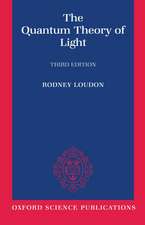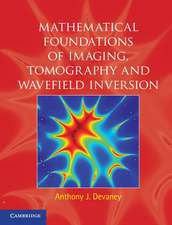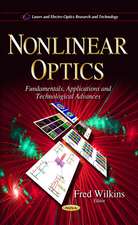The Physics of Invisibility: A Story of Light and Deception
Autor Martin Beechen Limba Engleză Paperback – 26 oct 2011
Preț: 188.94 lei
Nou
Puncte Express: 283
Preț estimativ în valută:
36.16€ • 37.61$ • 29.85£
36.16€ • 37.61$ • 29.85£
Carte disponibilă
Livrare economică 24 martie-07 aprilie
Preluare comenzi: 021 569.72.76
Specificații
ISBN-13: 9781461406150
ISBN-10: 1461406153
Pagini: 224
Ilustrații: XVII, 206 p. 135 illus., 55 illus. in color.
Dimensiuni: 155 x 235 x 12 mm
Greutate: 0.45 kg
Ediția:2012
Editura: Springer
Colecția Springer
Locul publicării:New York, NY, United States
ISBN-10: 1461406153
Pagini: 224
Ilustrații: XVII, 206 p. 135 illus., 55 illus. in color.
Dimensiuni: 155 x 235 x 12 mm
Greutate: 0.45 kg
Ediția:2012
Editura: Springer
Colecția Springer
Locul publicării:New York, NY, United States
Public țintă
Popular/generalCuprins
Introduction.- Chapter 1: Of All Things Visible and Invisible.- Chapter 2: A Very Brief History of Light.- Chapter 3: Mirror Tricks, the Art of Cloaking and Seeing the Impossible.- Chapter 4: Maxwell's Marvelous Waves.- Chapter 5: The Metamaterial Revolution.- Afterword.- Appendices.- Index.
Recenzii
From the reviews:
“Beech … eases readers into the topic after explaining the well-known behavior of light and giving examples of tricks of optics from magic, art, and nature. … This book is packed with fascinating examples of current work and possibilities for the future. Drawings and photographs help illustrate the physics. Summing Up: Highly recommended. Upper-division undergraduates through professionals; general readers.” (M. Dickinson, Choice, Vol. 49 (10), June, 2012)
“Beech … eases readers into the topic after explaining the well-known behavior of light and giving examples of tricks of optics from magic, art, and nature. … This book is packed with fascinating examples of current work and possibilities for the future. Drawings and photographs help illustrate the physics. Summing Up: Highly recommended. Upper-division undergraduates through professionals; general readers.” (M. Dickinson, Choice, Vol. 49 (10), June, 2012)
Notă biografică
Martin Beech is a Professor of Astronomy at Campion College, the University of Regina in Saskatchewan, Canada. He has written numerous research articles on topics ranging from meteor physics, Martian meteories, stellar structure and evolution, cosmology, the history of science and mathematical number theory. He lives in Regina with more than visible wife, a brother-in-law, five dogs (a.k.a The Five Pugs of the Apocalypse) and three cats - there are times when he certainly wishes he could be invisible.
Textul de pe ultima copertă
Arthur C. Clarke famously wrote that, "any sufficiently advanced technology is indistinguishable from magic." These words most certainly ring true with respect to invisibility cloaking devices. At work is the magic of science, of course. The technology to make an object simply disappear from view is now a reality.
There is both great fear and great desire in the thought of invisibility. Indeed, for thousands of years, authors have grappled with the idea. Power, devilry, secrecy, ethical dilemma, and moral corruption - invisibility has it all. And yet, our waking world is full of familiar invisible phenomena. Electricity flowing along a metal wire, the gravity that keeps us grounded, the air we breathe, the bacteria and viruses that make us ill, the X-rays that reveal our broken bones - all are invisible to our eyes. They surround and envelop us, and we don't give them a second thought.
Nature long ago learned how to play tricks with light rays, enriching the world with rainbows, mirages, and animal camouflage. The new physics of invisibility simply aims to take these tricks of nature a few steps further. Indeed, by learning what light is and how it interacts with matter, physicists have begun to take control of light - with metamaterials, which, manmade, can be precisely melded, warped, twisted, transformed, and even time-edited.
In this book the ancient and modern story of light and invisibility is revealed, from early Greek speculations to the remarkable works of James Clerk Maxwell. The new and burgeoning field of transformation optics is also explored, and the story behind the development of the first fully functional invisibility cloak is charted. What will they be used for and how will they change things? Find out here.
There is both great fear and great desire in the thought of invisibility. Indeed, for thousands of years, authors have grappled with the idea. Power, devilry, secrecy, ethical dilemma, and moral corruption - invisibility has it all. And yet, our waking world is full of familiar invisible phenomena. Electricity flowing along a metal wire, the gravity that keeps us grounded, the air we breathe, the bacteria and viruses that make us ill, the X-rays that reveal our broken bones - all are invisible to our eyes. They surround and envelop us, and we don't give them a second thought.
Nature long ago learned how to play tricks with light rays, enriching the world with rainbows, mirages, and animal camouflage. The new physics of invisibility simply aims to take these tricks of nature a few steps further. Indeed, by learning what light is and how it interacts with matter, physicists have begun to take control of light - with metamaterials, which, manmade, can be precisely melded, warped, twisted, transformed, and even time-edited.
In this book the ancient and modern story of light and invisibility is revealed, from early Greek speculations to the remarkable works of James Clerk Maxwell. The new and burgeoning field of transformation optics is also explored, and the story behind the development of the first fully functional invisibility cloak is charted. What will they be used for and how will they change things? Find out here.
Caracteristici
Describes in general terms how light can be manipulated to produce a distortion of images, known as invisibility Introduces the scientifically new technology of "invisibility cloaking," a technology currently heavily funded by the U.S. military Explores the current discussion of the use and ethics of invisibility Includes supplementary material: sn.pub/extras













